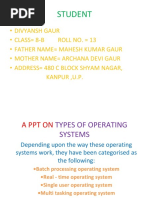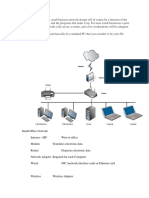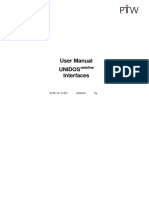Basic OpenLdap Tutorial
Uploaded by
Haldar RajarshiBasic OpenLdap Tutorial
Uploaded by
Haldar Rajarshifollow the steps described below for openldap installation as and configurations 1.
Installationinstall the following rpms from fedora cd/dvd. It will be best if you make a yum repo before installation that way you can avoid any dependency error during installations install the following rpms openldap-xx.rpm openldap-clients-xxxx.rpm openldap-servers-xxx.rpm openldap-devel-xxx.rpm x = version numbers 2. configurations There are two catagories of commands a. offline commands: these command are used when ldap server service is not running. e.g. slapadd/slapcat etc b. online commands : these command are used when ldap server service is running. e.g. ldapadd/ldapmodify/ldapdelete/ldapsearch etc Remember one thing ldap is a protocol and openldap is a software that implements ldap protocol. it actually holds all the objects of your domain e.g. printers/users/organistational units of the domain. Another important point is that ldap holds its data like a tree. e.g. lets say the domain abc.com contains 2 ou (organistational units) sales.abc.com and tech.abc.com. Now sales.abc.com contains 2 users x and y. Similarly tech.abc.com contains 2 users m and n. refer to the pic1.jpg. In ldap terms we will call abc.com as dc=abc,dc=com tech.abc.com as ou=tech,dc=abc.com sales.abc.com as ou=sales,dc=abc,dc=abc,dc=com x as dn: cn=x, ou=sales, dc=abc,dc=com here dc : domain component ou : organisational unit cn: common name (basically full name) sn : surname
uid : user id now let us implement this abc.com domain in openldap few important directories /etc/openldap/ : contains openldap configurations files /var/lib/ldap/ : contains databases of data which is added to openldap via ldapadd/slapadd command ----now follow the steps below cd /etc/openldap/ cp slapd.conf slapd.conf.bak vim slapd.conf database suffix rootdn rootpw bdb "dc=abc,dc=com" "cn=Manager,dc=abc,dc=com" password
remember to remove the space before rootpw. $$$$$$$$$$$$$$$$$$$$$ here Manager is our ldap administrator. adminstrator has the privilage to read/write/modify/delete any data. now start ldap service /etc/init.d/ldap start add root domain for this we will create a file named abc.ldif ( name and extension has no effect but it is standard to maintain ldif extension). enter attributes of root domain one per line as described below. vim abc.ldif dn: dc=abc,dc=com dc: cms description: Root LDAP entry for cms objectClass: dcObject objectClass: organizationalUnit
objectClass: domainRelatedObject ou: rootObject save and exit now create another 2 files for sales (sales.ldif) and tech (tech.ldif) vim sales.ldif dn: dc=sales,dc=abc,dc=com dc: sales description: organisational unit of sales Department objectClass: dcObject objectClass: organizationalUnit objectClass: domainRelatedObject ou: rootObject save and exit vim tech.ldif dn: dc=tech,dc=abc,dc=com dc: tech description: orgainsational unit of tech Department objectClass: dcObject objectClass: organizationalUnit objectClass: domainRelatedObject ou: rootObject save and exit now create another 2 files for user x and a vim x.ldif dn: cn=x,dc=sales,dc=abc,dc=com cn: x sn: x objectClass: top objectClass: person objectClass: posixAccount objectClass: inetOrgPerson mail: x@abc.com uid: x uidNumber: 1000 gidNumber: 1000
homeDirectory: /home/x userPassword: pass$123 save and exit vim a.ldif dn: cn=a,dc=tech,dc=abc,dc=com cn: a sn: a objectClass: top objectClass: person objectClass: posixAccount objectClass: inetOrgPerson mail: a@abc.com uid: a uidNumber: 10001 gidNumber: 1000 homeDirectory: /home/a userPassword: pass$123 save and exit now we will add these data to ldap. a. add root domain ldapadd -x -W -D "cn=Manager,dc=abc,dc=com" -f abc.ldif it will ask for password. enter "password" as password. b. add sales ou. ldapadd -x -W -D "cn=Manager,dc=abc,dc=com" -f sales.ldif it will ask for password. enter "password" as password. c. add tech ou. ldapadd -x -W -D "cn=Manager,dc=abc,dc=com" -f tech.ldif it will ask for password. enter "password" as password. d. add user x. ldapadd -x -W -D "cn=Manager,dc=abc,dc=com" -f x.ldif it will ask for password. enter "password" as password.
e. add user a. ldapadd -x -W -D "cn=Manager,dc=abc,dc=com" -f a.ldif it will ask for password. enter "password" as password. now our ldap is holding the domain abc.com and it's objects. now we can use this database to authenticate any service. let us search for data ldapsearch -x -b "dc=abc,dc=com" "(uid=*)" ldapsearch -x -b "dc=abc,dc=com" "(uid=x)"
You might also like
- Myhotspot, Billing Hotspot 2013 Gratis Dan Dapat Sepenuhnya DigunakanNo ratings yetMyhotspot, Billing Hotspot 2013 Gratis Dan Dapat Sepenuhnya Digunakan10 pages
- Configuration of a Simple Samba File Server, Quota and Schedule BackupFrom EverandConfiguration of a Simple Samba File Server, Quota and Schedule BackupNo ratings yet
- Nutanix Community Edition Getting StartedNo ratings yetNutanix Community Edition Getting Started25 pages
- Computer Networking: A Top Down Approach: 6 Edition Jim Kurose, Keith Ross Addison-Wesley March 2012No ratings yetComputer Networking: A Top Down Approach: 6 Edition Jim Kurose, Keith Ross Addison-Wesley March 201216 pages
- How To Copy or Move Files From One Folder To Another Based On A List in ExcelNo ratings yetHow To Copy or Move Files From One Folder To Another Based On A List in Excel8 pages
- How To Whitelist Hosts - IP Addresses in PostfixNo ratings yetHow To Whitelist Hosts - IP Addresses in Postfix3 pages
- A PPT On Types of Operating Systems by Divyansh Gaur100% (1)A PPT On Types of Operating Systems by Divyansh Gaur8 pages
- WebERP Manual Installation & Configuration100% (1)WebERP Manual Installation & Configuration18 pages
- What Is Ntop?: Ntop, Persistent Data and RRDNo ratings yetWhat Is Ntop?: Ntop, Persistent Data and RRD13 pages
- ManageEngine ServiceDeskPlusMSP 8.1 Help InstallationGuideNo ratings yetManageEngine ServiceDeskPlusMSP 8.1 Help InstallationGuide49 pages
- Memory, Storage (RAM, Cache, HDD, ODD, SSD, Flashdrives)No ratings yetMemory, Storage (RAM, Cache, HDD, ODD, SSD, Flashdrives)57 pages
- Best SCCM Training - 100% Free Online DemoNo ratings yetBest SCCM Training - 100% Free Online Demo6 pages
- A Review and Research Towards Cloud ComputingNo ratings yetA Review and Research Towards Cloud Computing3 pages
- Proxy Server: For Wikipedia's Policy On Editing From Open Proxies, Please SeeNo ratings yetProxy Server: For Wikipedia's Policy On Editing From Open Proxies, Please See11 pages
- Introduction To Drupal: Robert Castelo, CTO, Code PositiveNo ratings yetIntroduction To Drupal: Robert Castelo, CTO, Code Positive53 pages
- Migration Services - IBM Lotus Notes To MS Office 365: A. Questions and AnswersNo ratings yetMigration Services - IBM Lotus Notes To MS Office 365: A. Questions and Answers5 pages
- 127 Useful Keyboard Shortcuts For Windows 7No ratings yet127 Useful Keyboard Shortcuts For Windows 79 pages
- Orion - Production Server Hardware Requirements Database ServerNo ratings yetOrion - Production Server Hardware Requirements Database Server15 pages
- How To Install Apache Tomcat 8 On Ubuntu 16No ratings yetHow To Install Apache Tomcat 8 On Ubuntu 1625 pages
- Network Technician Resume Example Comcast PA - DE LMC - Plymouth Meeting, PennsylvaniaNo ratings yetNetwork Technician Resume Example Comcast PA - DE LMC - Plymouth Meeting, Pennsylvania2 pages
- Technical Support What Are The Main Responsibilities?No ratings yetTechnical Support What Are The Main Responsibilities?6 pages
- Mastering The XMPP Framework: Develop XMPP Chat Applications for iOSFrom EverandMastering The XMPP Framework: Develop XMPP Chat Applications for iOS4.5/5 (2)
- Lotus Domino Interview Questions, Answers, and Explanations: Lotus Domino Certification ReviewFrom EverandLotus Domino Interview Questions, Answers, and Explanations: Lotus Domino Certification ReviewNo ratings yet
- High Performance Computing BD4071 Unit 1 NotesNo ratings yetHigh Performance Computing BD4071 Unit 1 Notes28 pages
- Troubleshooting Tips For Cisco 3750X Stack Power FeatureNo ratings yetTroubleshooting Tips For Cisco 3750X Stack Power Feature6 pages
- Documentatie Proiect Tehnic+Detalii de Executie Arhitectura: Borderou de Piese Scrise Si DesenateNo ratings yetDocumentatie Proiect Tehnic+Detalii de Executie Arhitectura: Borderou de Piese Scrise Si Desenate4 pages
- Metaswitch Perimeta SBC Product BrochureNo ratings yetMetaswitch Perimeta SBC Product Brochure4 pages
- Oxe12.1 SD Crystalhwsystemboards 8AL91020USAG 1 enNo ratings yetOxe12.1 SD Crystalhwsystemboards 8AL91020USAG 1 en92 pages
- User Manual: Installation Poe Injector Spider Giga 2Tx Poe EecNo ratings yetUser Manual: Installation Poe Injector Spider Giga 2Tx Poe Eec28 pages
- Redundancy:: o Redundancy, Failover, High Availability, Clustering, RAID and Fault-ToleranceNo ratings yetRedundancy:: o Redundancy, Failover, High Availability, Clustering, RAID and Fault-Tolerance19 pages
- WIRIS Editor and WIRIS Plugins For Developers-1.4No ratings yetWIRIS Editor and WIRIS Plugins For Developers-1.46 pages
- Model View Controller Design Pattern OverviewNo ratings yetModel View Controller Design Pattern Overview4 pages
- CCIE Enterprise Wireless Cisco DNAc Integration With Catalyst 9800No ratings yetCCIE Enterprise Wireless Cisco DNAc Integration With Catalyst 980010 pages
- 602-LTE ENB System Counter Description - pkg2.5.0 - V2.0No ratings yet602-LTE ENB System Counter Description - pkg2.5.0 - V2.0359 pages
- SkyVision VSAT Installation Manual (Version 1)100% (5)SkyVision VSAT Installation Manual (Version 1)65 pages
- Instant Download Java Network Programming Fourth Edition Harold Elliotte PDF All Chapters100% (6)Instant Download Java Network Programming Fourth Edition Harold Elliotte PDF All Chapters65 pages
- Dell™ Optiplex™ 380 Service Manual - Mini-Tower: Notes, Cautions, and WarningsNo ratings yetDell™ Optiplex™ 380 Service Manual - Mini-Tower: Notes, Cautions, and Warnings54 pages
- Icaict202a Short Answer Questions - AnswersNo ratings yetIcaict202a Short Answer Questions - Answers5 pages
- Myhotspot, Billing Hotspot 2013 Gratis Dan Dapat Sepenuhnya DigunakanMyhotspot, Billing Hotspot 2013 Gratis Dan Dapat Sepenuhnya Digunakan
- Configuration of a Simple Samba File Server, Quota and Schedule BackupFrom EverandConfiguration of a Simple Samba File Server, Quota and Schedule Backup
- Computer Networking: A Top Down Approach: 6 Edition Jim Kurose, Keith Ross Addison-Wesley March 2012Computer Networking: A Top Down Approach: 6 Edition Jim Kurose, Keith Ross Addison-Wesley March 2012
- How To Copy or Move Files From One Folder To Another Based On A List in ExcelHow To Copy or Move Files From One Folder To Another Based On A List in Excel
- A PPT On Types of Operating Systems by Divyansh GaurA PPT On Types of Operating Systems by Divyansh Gaur
- ManageEngine ServiceDeskPlusMSP 8.1 Help InstallationGuideManageEngine ServiceDeskPlusMSP 8.1 Help InstallationGuide
- Memory, Storage (RAM, Cache, HDD, ODD, SSD, Flashdrives)Memory, Storage (RAM, Cache, HDD, ODD, SSD, Flashdrives)
- Proxy Server: For Wikipedia's Policy On Editing From Open Proxies, Please SeeProxy Server: For Wikipedia's Policy On Editing From Open Proxies, Please See
- Introduction To Drupal: Robert Castelo, CTO, Code PositiveIntroduction To Drupal: Robert Castelo, CTO, Code Positive
- Migration Services - IBM Lotus Notes To MS Office 365: A. Questions and AnswersMigration Services - IBM Lotus Notes To MS Office 365: A. Questions and Answers
- Orion - Production Server Hardware Requirements Database ServerOrion - Production Server Hardware Requirements Database Server
- Network Technician Resume Example Comcast PA - DE LMC - Plymouth Meeting, PennsylvaniaNetwork Technician Resume Example Comcast PA - DE LMC - Plymouth Meeting, Pennsylvania
- Technical Support What Are The Main Responsibilities?Technical Support What Are The Main Responsibilities?
- Mastering The XMPP Framework: Develop XMPP Chat Applications for iOSFrom EverandMastering The XMPP Framework: Develop XMPP Chat Applications for iOS
- Lotus Domino Interview Questions, Answers, and Explanations: Lotus Domino Certification ReviewFrom EverandLotus Domino Interview Questions, Answers, and Explanations: Lotus Domino Certification Review
- Troubleshooting Tips For Cisco 3750X Stack Power FeatureTroubleshooting Tips For Cisco 3750X Stack Power Feature
- Documentatie Proiect Tehnic+Detalii de Executie Arhitectura: Borderou de Piese Scrise Si DesenateDocumentatie Proiect Tehnic+Detalii de Executie Arhitectura: Borderou de Piese Scrise Si Desenate
- Oxe12.1 SD Crystalhwsystemboards 8AL91020USAG 1 enOxe12.1 SD Crystalhwsystemboards 8AL91020USAG 1 en
- User Manual: Installation Poe Injector Spider Giga 2Tx Poe EecUser Manual: Installation Poe Injector Spider Giga 2Tx Poe Eec
- Redundancy:: o Redundancy, Failover, High Availability, Clustering, RAID and Fault-ToleranceRedundancy:: o Redundancy, Failover, High Availability, Clustering, RAID and Fault-Tolerance
- CCIE Enterprise Wireless Cisco DNAc Integration With Catalyst 9800CCIE Enterprise Wireless Cisco DNAc Integration With Catalyst 9800
- 602-LTE ENB System Counter Description - pkg2.5.0 - V2.0602-LTE ENB System Counter Description - pkg2.5.0 - V2.0
- Instant Download Java Network Programming Fourth Edition Harold Elliotte PDF All ChaptersInstant Download Java Network Programming Fourth Edition Harold Elliotte PDF All Chapters
- Dell™ Optiplex™ 380 Service Manual - Mini-Tower: Notes, Cautions, and WarningsDell™ Optiplex™ 380 Service Manual - Mini-Tower: Notes, Cautions, and Warnings

























































































